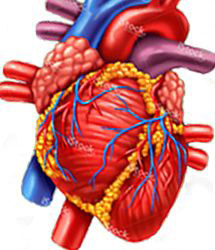 Coronary artery disease (CAD), also known as coronary heart disease (CHD, is a narrowing of the small blood vessels that supply blood and oxygen to the heart.
Coronary artery disease (CAD), also known as coronary heart disease (CHD, is a narrowing of the small blood vessels that supply blood and oxygen to the heart.
Symptoms may be very noticeable, but sometimes you can have the disease and not have any symptoms. Chest pain or discomfort (angina) is the most common symptom. You feel this pain when the heart is not getting enough blood or oxygen. How bad the pain is varies from person to person. It may feel heavy or like someone is squeezing your heart. You feel it under your breast bone (sternum), but also in your neck, arms, stomach, or upper back. The pain usually occurs with activity or emotion, and goes away with rest or a medicine called nitroglycerin. Other symptoms include shortness of breath and fatigue with activity (exertion).
Women, elderly people, and people with diabetes are more likely to have symptoms other than chest pain, such as:
- Fatigue
- Shortness of breath
- Weakness
